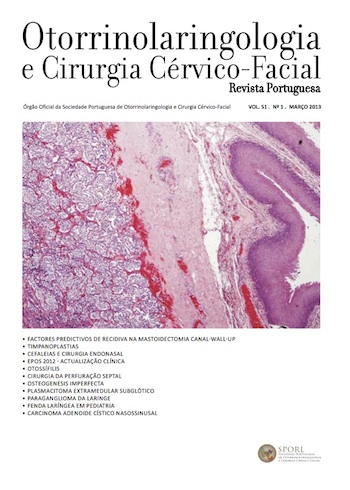Prevalência e características de SAOS Posicional, um estudo retrospetivo
DOI:
https://doi.org/10.34631/sporl.1065Palavras-chave:
Síndrome de Apneia Obstrutiva do Sono, SAOS, PosicionalResumo
Objetivos: Comparar a prevalência de SAOS Posicional (SAOS-P) com base em diferentes definições e identificar os principais fatores independentemente associados com SAOS-P e SAOS-P exclusiva (SAOS-Pe).
Desenho do Estudo: Estudo retrospetivo.
Material e Métodos: Análise do registo de polissonografia (PSG) tipo 3 de doentes adultos realizadas entre 2020 e 2021 no Serviço de Otorrinolaringologia do Hospital Garcia de Orta. Definiu-se SAOS-P pelos critérios de APOC e a SAOS-Pe foi definida como APOC I.
Resultados: Foram avaliadas 245 PSG, onde se verificou uma idade média de 57 anos e 64,9% de doentes do género masculino. A prevalência de SAOS-P foi de 55,5%, 38% dos quais apresentava SAOS-Pe. Os doentes com SAOS-P eram mais novos (OR=0,971), dormiram maioritariamente em posição supina (OR=1,031), tinham menor Índice de Massa Corporal (IMC) (OR=0,882), Índice de Apneia/Hipopneia (IAH), índice de dessaturação de oxigénio (OR=0,964), média da queda de dessaturação, e menor tempo de roncopatia (p<0,05). Os fatores preditores de SAOS-Pe mais significativos foram um menor índice de dessaturação de oxigénio (OR=0,879) e maior tempo em posição supina (OR=1,031).
Conclusões: Os doentes com SAOS-P e SAOS-Pe são mais novos, menos obesos e apresentam quadros menos graves, sendo respetivamente candidatos a melhoria ou resolução da sua doença com recurso a posicionadores.
Downloads
Referências
Yingjuan M, Siang WH, Leong Alvin TK, Poh HP. Positional therapy for positional obstructive sleep apnea. Sleep Med Clin. 2020 Jun;15(2):261-275. doi: 10.1016/j.jsmc.2020.02.012.
Cartwright RD. Effect of sleep position on sleep apnea severity. Sleep. 1984;7(2):110-4. doi: 10.1093/sleep/7.2.110.
Levendowski DJ, Seagraves S, Popovic D, Westbrook PR. Assessment of a neck-based treatment and monitoring device for positional obstructive sleep apnea. J Clin Sleep Med. 2014 Aug 15;10(8):863-71. doi: 10.5664/jcsm.3956.
Frank MH, Ravesloot MJ, van Maanen JP, Verhagen E, de Lange J, de Vries N. Positional OSA part 1: Towards a clinical classification system for position-dependent obstructive sleep apnoea. Sleep Breath. 2015 May;19(2):473-80. doi: 10.1007/s11325-014-1022-9.
Ravesloot MJ, Frank MH, van Maanen JP, Verhagen EA, de Lange J, de Vries N. Positional OSA part 2: retrospective cohort analysis with a new classification system (APOC). Sleep Breath. 2016 May;20(2):881-8. doi: 10.1007/s11325-015-1206-y.
Oulhaj A, Al Dhaheri S, Su BB, Al-Houqani M. Discriminating between positional and non-positional obstructive sleep apnea using some clinical characteristics. Sleep Breath. 2017 Dec;21(4):877-884. doi: 10.1007/s11325-017-1499-0.
Sabil A, Blanchard M, Annweiler C, Bailly S, Goupil F, Pigeanne T. et al. Positional obstructive sleep apnea within a large multicenter French cohort: prevalence, characteristics, and treatment outcomes. J Clin Sleep Med. 2020 Dec 15;16(12):2037-2046. doi: 10.5664/jcsm.8752.
Oksenberg A, Gadoth N, Toyras J, Leppanen T. Prevalence and characteristics of positional obstructive sleep apnea (POSA) in patients with severe OSA. Sleep Breath. 2020 Jun;24(2):551-559. doi: 10.1007/s11325-019-01897-1.
Levendowski DJ, Oksenberg A, Vicini C, Penzel T, Levi M, Westbrook PR. A systematic comparison of factors that could impact treatment recommendations for patients with Positional Obstructive Sleep Apnea (POSA). Sleep Med. 2018 Oct;50:145-151. doi: 10.1016/j.sleep.2018.05.012.
Berry RN, Albertaria CL, Harding SM, Lloyde RM, et al. The AASM Manual for the scoring of sleep and associated events: rules, terminology and technical specifications. Version 2.5. American Academy of Sleep Medicine. 2018. http://www.aasm.org.
Lee SA, Paek JH, Chung YS, Kim WS. Clinical features in patients with positional obstructive sleep apnea according to its subtypes. Sleep Breath. 2017 Mar;21(1):109-117. doi: 10.1007/s11325-016-1379-z.
Bignold JJ, Mercer JD, Antic NA, McEvoy RD, Catcheside PG. Accurate position monitoring and improved supine-dependent obstructive sleep apnea with a new position recording and supine avoidance device. J Clin Sleep Med. 2011 Aug 15;7(4):376-83. doi: 10.5664/JCSM.1194
Fietze I, Glos M, Zimmermann S, Penzel T. Long-term variability of the apnea-hypopnea index in a patient with mild to moderate obstructive sleep apnea. J Clin Sleep Med. 2020 Feb 15;16(2):319-323. doi: 10.5664/jcsm.8192.
Downloads
Publicado
Como Citar
Edição
Secção
Licença
Direitos de Autor (c) 2023 Os autores mantêm os direitos de autor deste artigo.

Este trabalho encontra-se publicado com a Licença Internacional Creative Commons Atribuição-CompartilhaIgual 4.0.






